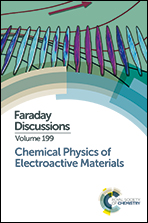Modifying surface forces through control of surface potentials†
Abstract
Combining direct surface force measurements with in situ regulation of surface potential provides an exceptional opportunity for investigating and manipulating interfacial phenomena. Recently, we studied the interaction between gold and mica surfaces in water with no added salt, while controlling the metal potential, and found that the surface charge at the metal may vary, and possibly even change its sign, as it progressively approaches the (constant-charge) mica surface [Langmuir, 2015, 31(47), 12845–12849]. Such a variation was found to directly affect the nature of the contact and adhesion between them due to exclusion of all mobile counterions from the intersurface gap. In this work, we extend this to examine the potential-dependent response of the adhesion and interaction between gold and mica to externally applied voltages and in electrolyte solution. Using a surface force balance (SFB) combined with a three-electrode electrochemical cell, we measured the normal interaction between gold and mica under surface potential regulation, revealing three interaction regimes – pure attraction, non-monotonic interaction from electrostatic repulsion to attraction (owing to charge inversion) and pure repulsion. Accordingly, the adhesion energy between the surfaces was found to vary both in no added salt water and, more strongly, in electrolyte solution. We justify this potential-dependent variation of adhesion energy in terms of the interplay between electrostatic energy and van der Waals (vdW) interaction at contact, and attribute the difference between the two cases to the weaker vdW interaction in electrolyte solution. Finally, we showed that through abruptly altering the gold surface potential from negative to positive and vice versa, the adhesion between gold and mica can be reversibly switched on and off. We surmise that the process of bringing the surface into contact is associated with the formation of a strong electric field O (108 V m−1) in the intersurface gap.
- This article is part of the themed collection: Chemical Physics of Electroactive Materials


 Please wait while we load your content...
Please wait while we load your content...